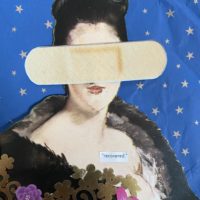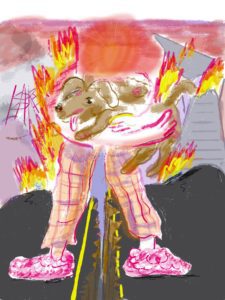It started up again with something innocuous: An extra pair of fuzzy slippers under my side of the bed in case the world ended at midnight. Each summer the California skies turn the color of a rusted cast iron from wildfire smoke. The frequent, rising king tides threaten to deposit flopping pink salmon on the doorstep like a Postal Service baby, surreal and unlikely but historically congruent. A new reality. The pandemic rages on. There’s war, immense and urgent suffering. But I’m not thinking of any of that. Instead, I am transfixed with the probability of earthquakes.
When I was a child, my mother convinced me our family had the gift of foresight. Her dreams told her a sister’s house would burn. A handful of years later, the candles at the altar Auntie Lisa kept for Saint Francis of Assisi tipped over, lit her house on fire, and killed her cockatiel. I find myself testing my inherited prediction abilities. I keep a journal of what I expect my colleagues will wear: Olivia will come in a pink beanie because there is a chill in the air; on Wednesday, Nana will wear Mary Janes with lacy anklet socks, the kind I wore to catechism class when I was learning to argue with God. I also predict the weather, avoiding checking the temperature and wind figures each morning before dawn until I test my own pattern observation.
From behind the thick yellow velvet curtains that I draw tight across our hundred-and-fifty-year-old bay windows, I watch the busy San Francisco one-way and guess which color the next car will be. There is a long crack in the wavy original glass on the angled eastern window. I suspect it happened the last time there was high-intensity shaking in the City by the Bay. Usually the cars that pass are the color of tapioca, smog, or newspaper ink, but sometimes they will be red like blood or calamitous fire.
At the hospital on the way to a mental health appointment, I reluctantly find myself in an elevator. I check which button is worn down the most, the floor most likely to be filled with people scrambling to escape. I imagine the regulars on the 7th floor trapped in this tin coffin without power, slowly starving over the days following the earthquake.
My therapist once and only once suggests I move from the city. It is an ugly suggestion, one that provokes a strangled bark from deep inside of me. I will never leave San Francisco; of all the places I’ve lived, it has felt like the only place that fits me. I will haunt it if it kills me.
I have comorbidities. They are like silica gel packets hidden in my genetic gifts. When I list the mental health conditions under prior diagnoses, I avoid talking about my postpartum OCD. I repeat to myself that it was purely hormonal. It was a response to the stresses of a newborn. It was a series of vivid, terrifying visions of dropping my admittedly slippery baby on her soft avocado head, of accidentally swerving our family vehicle into the grill of a Volvo-manufactured semi truck full of Mountain Dew, of my child’s trailing blanket slipping into the spot on the mall escalator where the ground eats itself. I do not think it will come back.
I know all of the visitors. Depression is a wooly black dog, curling alongside me in bed. Anxiety is the one who grows legs and scratches at the door, begging to go but bloodshot with nerves. OCD is mangy, covered in raw spots where she can’t stop rubbing her canines against the flesh. To tame a flea-ridden dog, you need to name it. I set to work.
Recently I found a 600-page government-created earthquake scenario named HayWired, and consumed two full days reading a report that ultimately said we cannot predict The Big One. It could happen on a foggy June Sunday while I picnic with my children on damp grass, or it could happen in thirty years. The uncertainty is unsettling, particularly for a person who chose her own engagement ring before letting the fellow propose. It is the same feeling I get when I see a rubbery, squeaking balloon at a children’s birthday party. It will pop, and I find my whole body wincing in preparation too far in advance. Hold on to that curled silk ribbon tether, now. Don’t let the balloon fly away.
Reading the HayWired Scenario is actually a cognitive behavioral therapy technique I picked up back in the hazy newborn days. Exposure therapy is frequently practiced through in vivo exposure, meaning approaching the monster in real life when possible. In my earthquake-specific case, I can’t confront the Hayward or the San Andreas. They are massive geological ancients hiding deep under the crust of the Earth. Instead I expose myself through reading. When done with the help of a coach, this seemingly cruel training method can allow someone to habituate their mangy dog, to turn it into a familiar or even a companion. When I recognize the familiar patterns setting in, I know what to do. That worst-case preparation involves, for me, taking courses on emergency management, choosing a family meeting spot on a hill near our house, and stocking a closet with supplies.
It is not normal, not my normal, to walk with insomnia in front of the windows like a Victorian ghost, repeating to myself the precise feet above sea level where I stand in case the impending strike slip causes a tsunami. Yet it is what calms my anxiety. I speak softly to myself. I do not lie. I do not say this earthquake won’t come; that would be like burying my head in sand. It will probably eventually happen. When I find myself so caught up in imagining the cracks in our walls, I say, “I bet that feels scary, knowing something completely out of your control could strike when you are vulnerable in bed.” I soothe the dog. I breathe in for five, hold it for five, breathe out for five, hold it for five. It is called the box breathing technique, a safe little box with a “crack me in case of emergency” sticker. I keep an ax next to my bleach spray in case I need to escape a collapsed roof. I have three Arrowhead water jugs, the kind you take on a family camping trip. And I keep a pair of soft, fuzzy, comforting slippers under my side of the bed in case I need to walk that whining, mangy dog in the night. Nobody would bat an eye at slippers under the bed. They wouldn’t think twice.
***
Themed month logo by Honey Gilmore, essay art by Liam Golden





